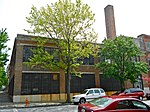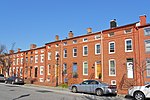Mount Clare Shops
Baltimore and Ohio RailroadBlacksmith shopsDefunct locomotive manufacturers of the United StatesIndustrial buildings and structures in MarylandIndustrial buildings and structures on the National Register of Historic Places in Baltimore ... and 8 more
National Historic Landmarks in MarylandRail transportation in MarylandRailway buildings and structures on the National Register of Historic Places in MarylandRailway workshops in the United StatesRailway workshops on the National Register of Historic PlacesSouthwest BaltimoreTransportation buildings and structures in BaltimoreUse mdy dates from August 2023

The Mount Clare Shops is the oldest railroad manufacturing complex in the United States, located in Baltimore, Maryland. It was founded by the Baltimore and Ohio Railroad (B&O) in 1829. Mt. Clare was the site of many inventions and innovations in railroad technology. It is now the site of the B&O Railroad Museum. The museum and Mt. Clare station were designated a National Historic Landmark in 1961.
Excerpt from the Wikipedia article Mount Clare Shops (License: CC BY-SA 3.0, Authors, Images).Mount Clare Shops
West Pratt Street, Baltimore Sowebo
Geographical coordinates (GPS) Address Website Nearby Places Show on map
Geographical coordinates (GPS)
| Latitude | Longitude |
|---|---|
| N 39.285457 ° | E -76.633437 ° |
Address
Baltimore and Ohio Railroad Museum (B&O Railroad Museum)
West Pratt Street 901
21223 Baltimore, Sowebo
Maryland, United States
Open on Google Maps










